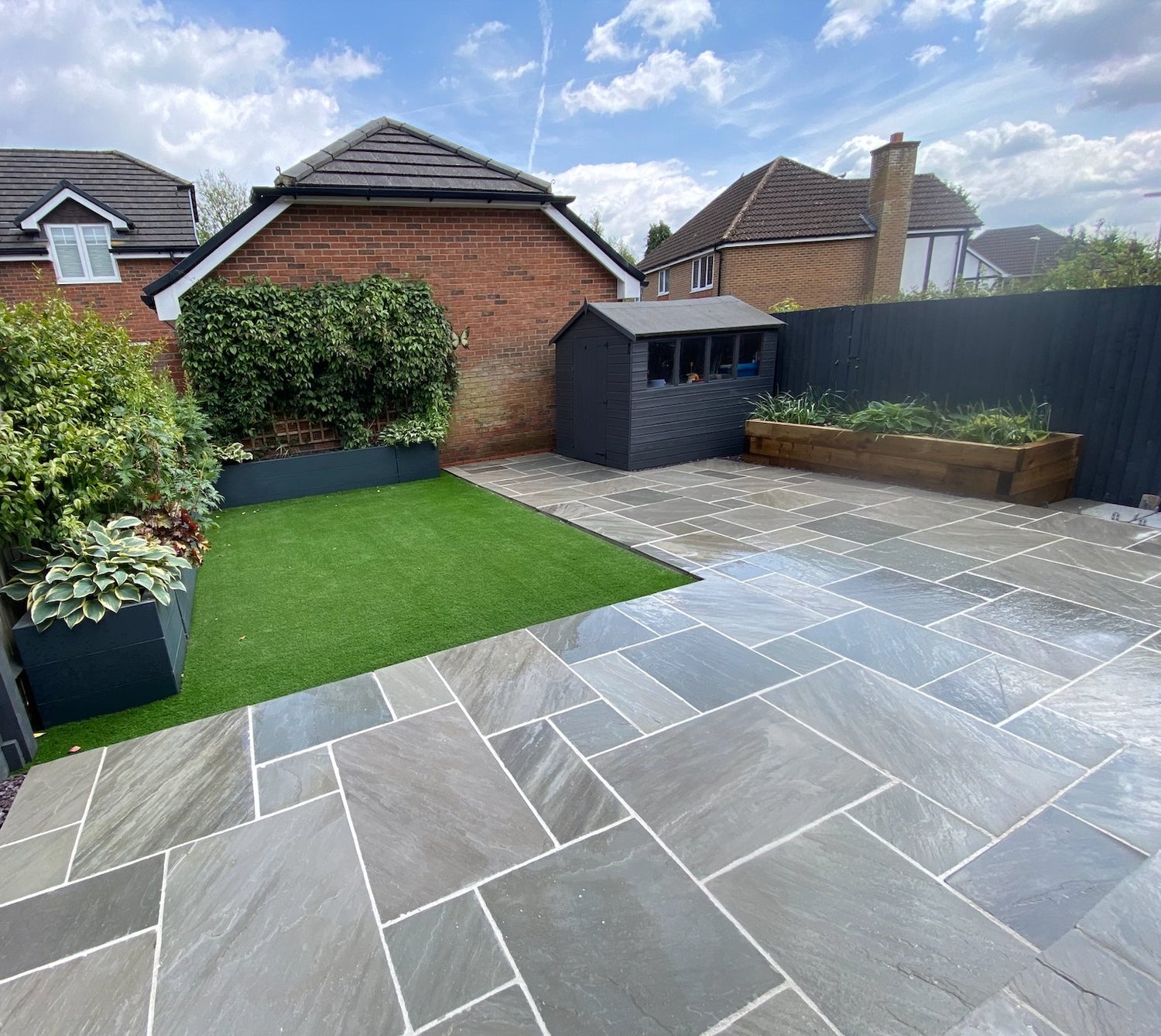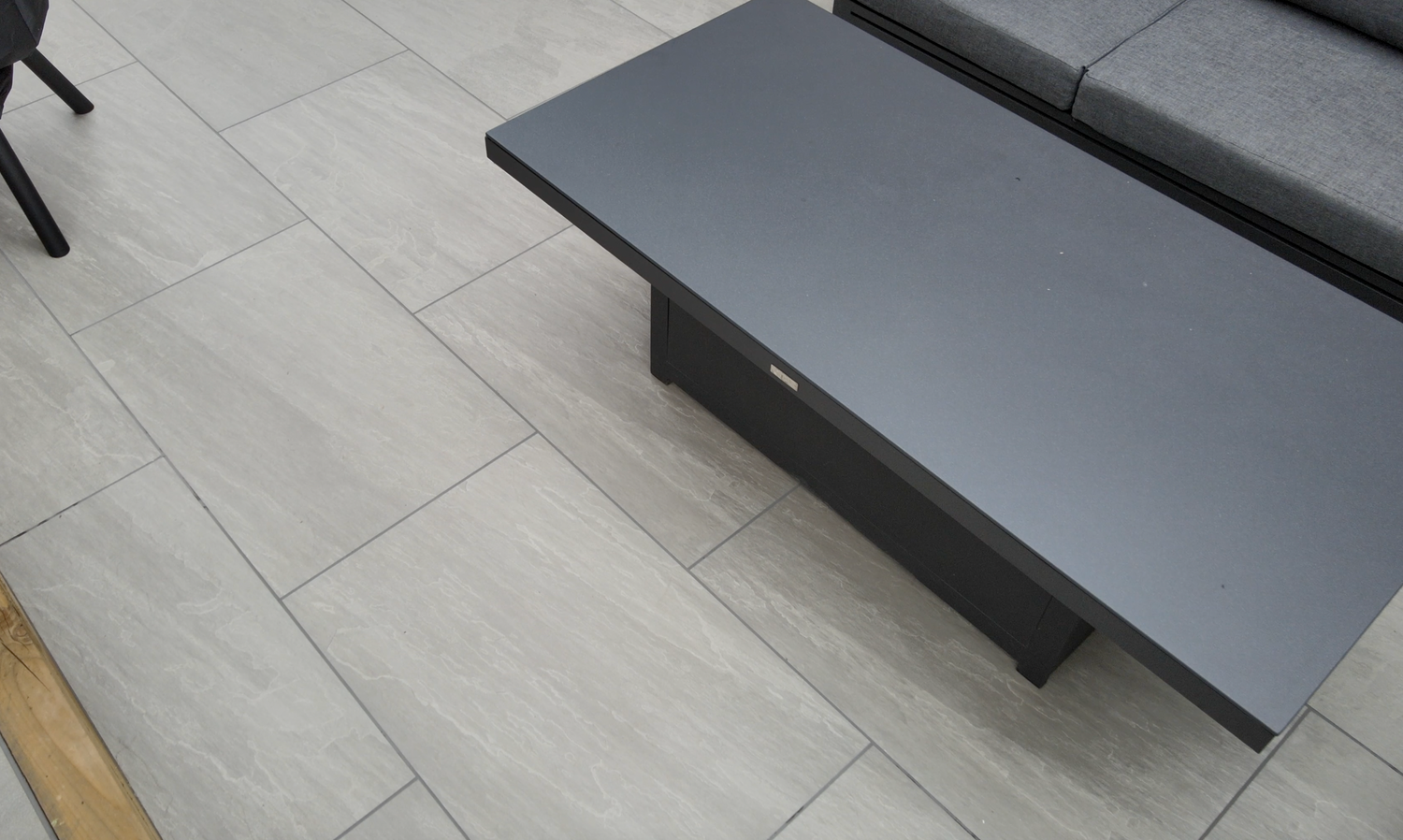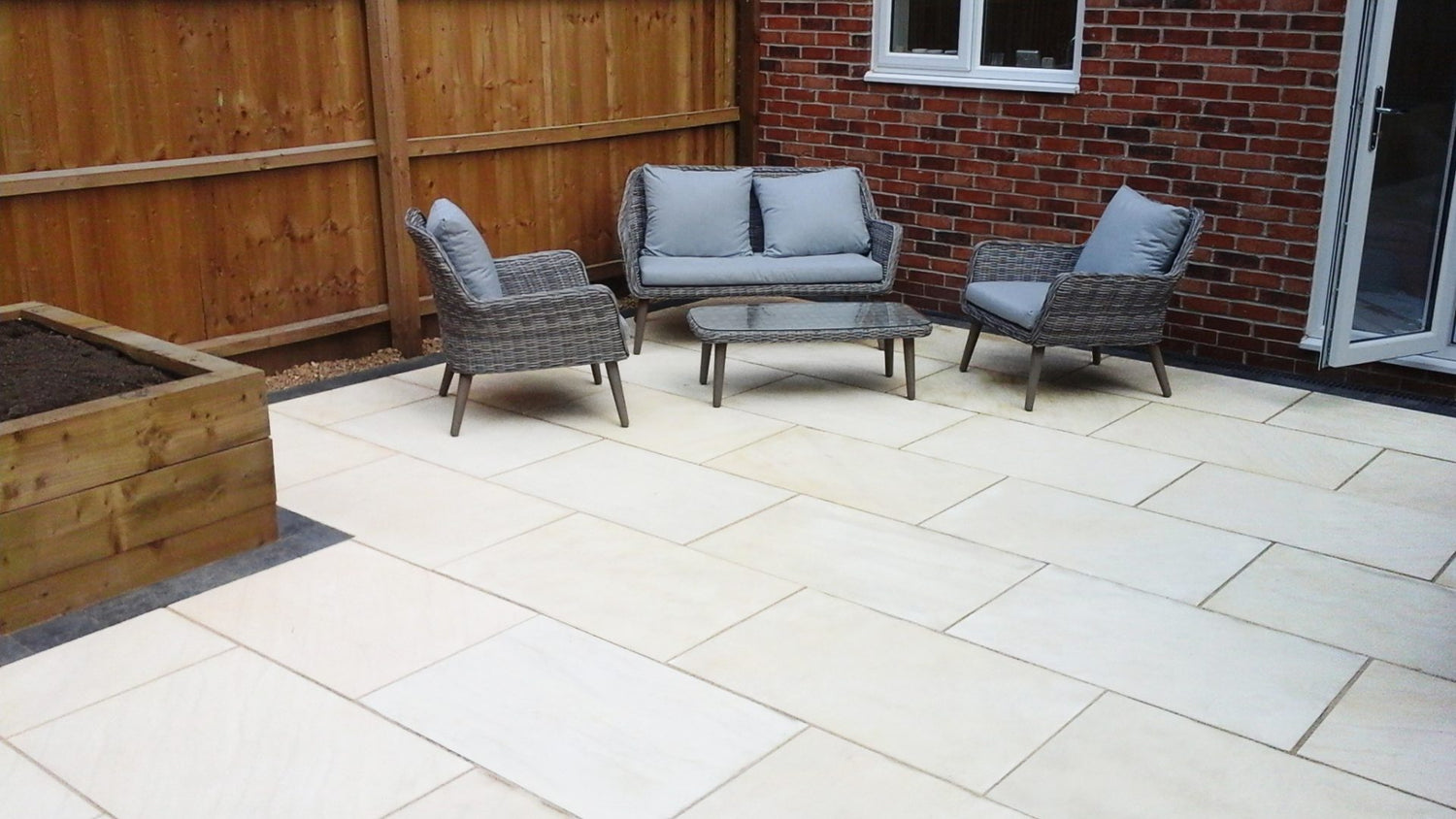
Pros and Cons of Sandstone Paving
Share
Pros & Cons of Indian Sandstone Paving
Indian sandstone paving is a natural and durable option that adds both beauty and functionality to your outdoor spaces. Whether you're designing a patio, driveway, or walkway, this versatile stone offers a range of benefits, from its aesthetic appeal to its longevity. However, it’s essential to weigh these advantages against potential drawbacks, like staining and the need for proper installation. In this guide, we'll explore the pros and cons of Indian sandstone paving, helping you make an informed decision for your outdoor project.
| Aspect | Pros | Cons |
|---|---|---|
| Appearance | Natural, distinctive style with multicolored stones and a unique finish, offering versatility in design. | May not uniformly match every outdoor décor theme due to its natural variation. |
| Durability | Highly durable, ideal for high-traffic areas and heavy impact zones. | Susceptible to cracking and chipping under extreme conditions or improper installation. |
| Maintenance | Low maintenance; requires regular cleaning and occasional sealing. | Prone to staining and discoloration, needing preventive measures like sealing. |
| Installation | Can be installed in various patterns to enhance outdoor aesthetics. | Requires professional installation for the best results and longevity. |
| Safety | Non-slip surface, making it safe for areas prone to moisture. | Texture might vary, which can impact its non-slip quality. |
| Cost | A cost-effective option compared to some other paving materials. | Can be expensive depending on the quality and source of the sandstone. |
| Eco-Friendliness | Sandstone is a natural product and can be an environmentally friendly option. | Quarrying and transportation may have an environmental impact. |
Why Choose Sandstone Paving?
Natural Warmth & Beauty - The sandy ripples and grains visible in varieties like our Kandla Grey range display the very origins and evolution of sandstone over millennia. Neutral creams through earthy greys and vibrant jewel tones bring a cozy ambiance to your outdoor space.
Textured & Safe Underfoot - Unlike finely honed stone, the natural cleft riven patio slabs provide grip and visual depth even when wet, making sandstone suitable for pool surrounds, play areas, and footpaths.
Strength & Durability - Made of tightly compacted quartz, feldspar, and other minerals, sandstone withstands heavy footfall and general wear and tear. Its durable surface also makes it an ideal choice for pet-friendly paving.
Budget & Eco-Friendly - Indian sandstone represents great value, starting at just £18 per m2. Locally sourced from reputable suppliers, our direct importing cuts transportation emissions too.
Easy Maintenance - Beyond an occasional sweep and seal, sandstone maintenance needs are simple. Our patio packs lend themselves to straightforward DIY installation.
Potential Cons of Sandstone Paving
With sandstone being permeable, some smart precautions ensure your sandstone patio or driveway delivers decades of enjoyment.
Moisture & Staining - Lack of sealing can allow spillages to penetrate stone over time, causing stubborn stains. But properly sealed and maintained, issues are rare. We offer detailed sealing guidance and aftercare support.
Slip Potential - While riven provides grip, smooth sandstone may become slippery when wet. Mitigate risk through added treatments in high-traffic zones. Opt for textured versions instead.
Surface Damage - Being softer than granite, sandstone can be prone to scratches from unprotected furniture movement. Damage is easily avoided by laying outdoor mats beneath tables and being careful when shifting items.
Extreme Temps - Rapid heating/cooling of stone may cause cracks. Proper base prep and avoiding laying in extreme heat minimizes this. Gradual temp changes are fine.
Our Indian Sandstone Collection
Browse our hand-selected sandstone slabs range, showcasing the diversity of natural Indian stone—from subtle creamy neutrals to vivid jewel tones brimming with sandy character.
We offer everything from matte riven patio slabs alongside precisely sawn contemporary options in smart geometries.
Is Indian Sandstone Good Quality?
Indian sandstone provides sufficient strength for regular domestic use, including as an underfoot surface for parking vehicles, making it suitable for driveways and patios. The stone also offers adequate durability for these regular domestic underfoot applications in driveways and patio areas when vehicles are parked on it.
Does Indian Sandstone Get Slippery?
Indian sandstone is known for its slip-resistant surface, making it a suitable choice for areas where slip resistance is a key consideration, such as around pools or in high-traffic locations. The non-slip characteristic of Indian sandstone contributes to its ability to provide a safe walking surface in these types of settings.
How Long Does Indian Sandstone Last?
Indian sandstone paving is a durable and long-lasting choice for outdoor spaces. The natural stone is strong and impact-resistant once laid, eliminating concerns about potential damage. With its hard-wearing properties, Indian sandstone paving can maintain its attractive appearance for 20-30 years or more with minimal maintenance.
Does Sandstone Offer Better Grip than Porcelain?
Yes, the naturally cleft riven texture of most Indian sandstone provides inherent traction underfoot, unlike smooth porcelain slabs, which can become slippery when wet. Sandstone suits pool surrounds, but porcelain is harder wearing for high traffic.
Is Sandstone Warmer Underfoot than Limestone or Concrete Paving?
Absolutely, the porous nature and earthy sandy hues allow sandstone to absorb and retain heat from the sun far better, keeping patios or paths warmer in winter. Meanwhile, smooth limestone slabs or stark concrete slabs remain chilly.
Can I Create Patterned Patios with Sandstone?
Yes, you can lay sandstone in an array of eye-catching layouts! We offer precision-cut circle packs and rectangle slabs options alongside versatile patio slab collections to create neat grid, basket weaves, offset, and more. Additionally, our range of sandstone paving colours ensures that every design is not only unique in layout but also in its vibrant and natural hues, perfectly bringing your paving ideas to life.
Related Posts
-

UK Garden Statistics and Trends 2024
UK Garden Statistics and Trends 2024 General UK Garden Statistics The vast majority of UK households have access to ...
-

Can I lay Paving on Soil or Mud?
Technically, yes – you can lay paving stones or slabs directly onto exposed topsoil however, laying a sub-base will e...
-

How Much Does a New Patio Cost?
A new patio in the UK typically costs between £80-£150 per square meter. For a 40-50 sqm patio, expect to pay £2,000-...
-

What Different Sizes Do Paving Slabs Come In?
When planning a patio or outdoor paving project, one of the key decisions is choosing the right size paving slabs. ...
-

Can You Pressure Wash Indian Sandstone?
Indian sandstone is a popular choice for outdoor paving due to its durability and attractive appearance. However, li...
-

Is Sandstone Paving Permeable? Is it porous?
Sandstone's porous nature enables it to absorb rainfall, qualifying it as a permeable paving variety. However, seali...
-

Where Does Natural Sandstone Paving Come From?
Sandstone begins deep underground, formed over eras as minerals and sediments fused under pressure. Powerful forces ...
-

5 Paving Ideas for Small Gardens: Maximise Your Outdoor Space
Front of House When considering paving ideas for the front of your house, it's crucial to select ones that complem...
-

9 Paving Ideas for Front of House: Enhancing Curb Appeal with Style
The facade of a house plays a pivotal role in defining its character and curb appeal, and the choice of paving can s...
-

9 Summer Garden Paving Ideas UK
Summer gardens offer a vibrant canvas for homeowners to express their style while enhancing outdoor living spaces. G...
-

8 Garden Paving Ideas for 2024
It's time to refresh your garden's look for 2024 and an easy way to do that is with some new paving. With so many opt...
-

How to remove moss from patio paving
Moss growth is a common issue for patio paving, especially in damp, shaded areas. While moss may seem harmless, it ca...
-

How much does sandstone paving cost?
When choosing new garden pavers, sandstone offers homeowners an enticing middle-ground - more durable than basic conc...
-

Why Do Paving Slabs Crack And How To Repair Them
Seeing cracks appear on your patio or driveway can be disheartening after investing time and money into installing be...
-

How to lay paving in winter (Tips & Tricks)
How Cold Temperatures Impact Paving Projects The primary concern when working in cold weather is ensuring proper curi...
-

Sub Bases For Patios
Building the Perfect Patio Base: A Comprehensive Guide When planning an outdoor living space, understanding proper ba...
-

Pros and Cons of Porcelain Paving
Are you considering adding porcelain paving to your outdoor space? It's important to weigh the pros and cons before ...
-

Understanding Paving Slip Ratings: A Comprehensive Guide
A paving slip rating, also known as a slip resistance or anti-slip rating, is a measure of how slippery a surface...
-

Stunning Garden Water Feature Ideas - Enhance Your Outdoor Space
Garden water features are decorative elements that incorporate water into a garden, adding beauty and a sense of ...
-

How to Stop Weeds in Block Paving: Expert Tips andTricks
Weeds growing between the blocks of your paving can be an unsightly and frustrating problem. Not only do they make y...
-

How to clean paving without a pressure washer
A patio cleaner is a cleaning solution designed specifically for removing dirt, grime, and stains from outdoor patio...
-

How to Grout Paving Slabs – Expert Tips and Techniques
Pointing paving slabs is an important step in the process of installing them. Grout is a mixture of cement, water...
-

Block Paving Guide | What Does it Cost? | How Much Per m2?
Block paving is a versatile and durable option for creating driveways, patios, and paths. This method involves using...
-

Porcelain VS Ceramic Paving
Porcelain paving is non-porous and more durable than ceramic paving, which is more porous and prone to stains and wea...
-
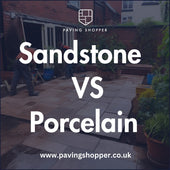
Sandstone V Porcelain Paving - (Style Comparison and Distinctions)
When choosing materials for your patio or driveway, two of the most popular options are sandstone paving slabs and p...
-

Understanding Gradients and Falls for Paving and Drainage (2024)
When it comes to paving and drainage projects, understanding the correct gradients and falls is essential for ensuri...
-
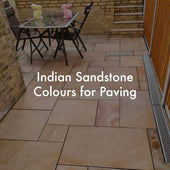
Indian Sandstone Paving Colours for A Patio - A Comprehensive Guide
Indian sandstone is one of the most popular paving materials, celebrated for its natural beauty and the variety of co...
-

Jointing and Pointing For Paving (Sand & Cement Mix)
Patio pointing is important for both looks and durability. It protects the layers under your paving, stops weeds, and...
-

How to Lay Paving on Sand and Cement: Expert Advice and Tips
Paving on Sand and Cement: A Comprehensive Guide When it comes to enhancing your outdoor space, paving is a popular ...
-
Does Patio Paving Need Edging? A Comprehensive Guide
In this article, we'll explore the importance of patio edging, the different types of edging materials available, and...
-

Pet Friendly Paving - What is the best paving for a dog-friendly garden?
Creating a dog-friendly garden requires choosing the right paving materials to ensure your furry friends can enjoy t...
-

Patio Paving Laying Patterns Guide
Paving patterns can transform an ordinary outdoor space into a stunning and eye-catching area that complements your ...
-

Patio Kits vs Single Size Paving Slabs: Which To Choose?
When designing a patio or outdoor space, one crucial decision is whether to use a patio kit (also known as patio pack...
-

Are paving slabs suitable for driveways?
This is a question many homeowners ask when it comes to choosing the right type of driveway surface for their home. T...
-

How much paving do you need to cover your outdoor space?
Planning an outdoor paving project is exciting, but it’s crucial to accurately estimate the amount of paving needed b...
-

What is the Best Paving for Patios?
When it comes to choosing the best paving for patios, there are a variety of factors to consider, such as durability,...
-
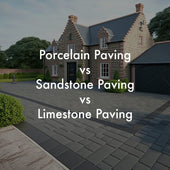
Sandstone v Limestone v Porcelain: The Pros and Cons of Different Garden Paving Materials
Transforming your outdoor space involves choosing the right paving material, and porcelain and sandstone are two of t...
-
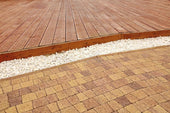
Are Paving Slabs Cheaper Than Decking?
Transforming your backyard into the ultimate outdoor oasis can be challenging when choosing between paving slabs or d...
-

How to lay a patio - An expert guide to laying paving slabs and patterns
There are a few things to consider before laying a patio, such as the type of paving stones and the laying pattern. Y...
-

How to cut Sandstone Paving?
When it comes to prepping your garden for a new patio, you may consider different designs that require your paving to...









































